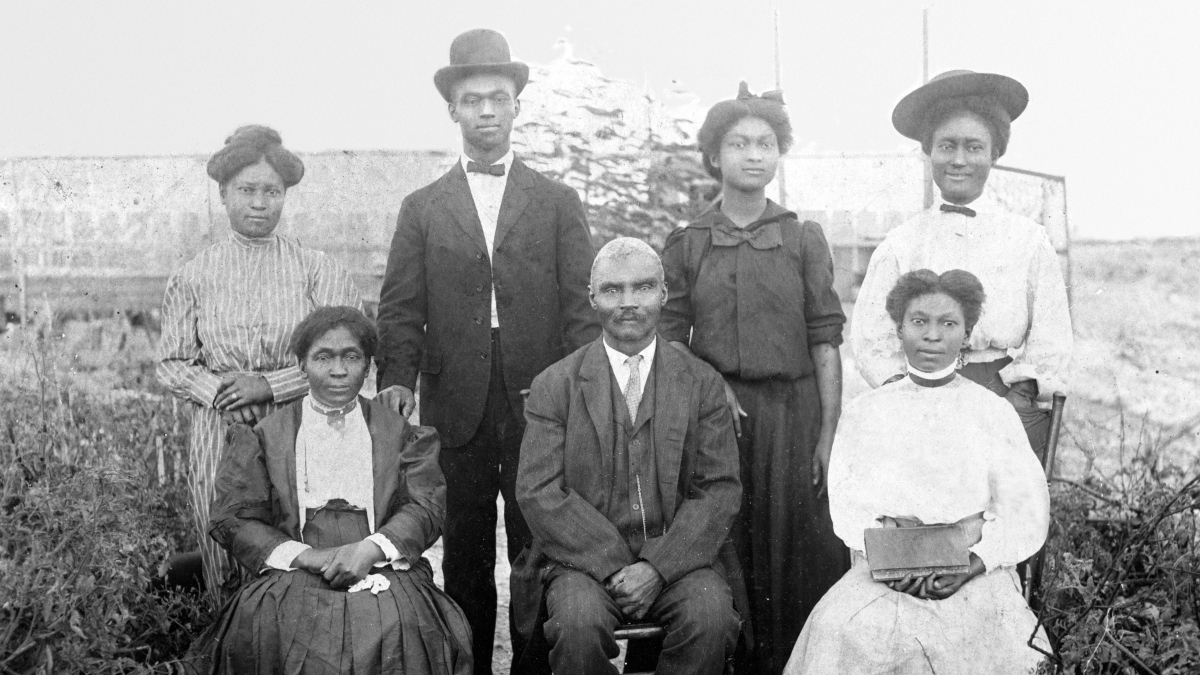 |
| The Goodwin family, with Henrietta seated at the far right. Photo courtesy San Diego History Center. |
About a decade ago, Beverly Goodwin received a message from a college friend that kept a significant part of her family history — and San Diego State University history — from being lost forever.
At the time, SDSU librarian Robert Fikes, Jr. was working on the book “The Black in Crimson and Black: History and Profiles of African Americans at SDSU.” In his research, Fikes had named 1913 alumna Henrietta Goodwin as the university’s first Black graduate.
Wanda Clay Majors, a counselor in SDSU’s Educational Opportunity Program (EOP), saw the last name. She saw a photo of Henrietta that bore striking resemblance to her friend. And she knew Beverly had family roots in San Diego. So she reached out.
It was a lucky break.
On a Zoom call from her Pittsburgh home, Beverly smiles as she recounts stories about her grandaunt and Goodwin forebearers. The granddaughter of Henrietta’s younger brother Lee, Beverly possesses a resume that would no doubt make her ancestor proud. She recently retired after 33 years as a professor of psychology with a specialty in clinical psychology at Indiana University of Pennsylvania.
“When I think of the Goodwins, that's what we do.” Beverly said. “Education has always been primary on both sides of my family, and especially among the Goodwins. I'm not the first generation or even the second or third generation to go to college, and we have earned advanced degrees.
“There's another thing about the Goodwins,” she added with a laugh. “Goodwins are talkers.”
True to form, Beverly took us on a journey through her family’s past — one replete with remarkable SDSU connections.
The Goodwin Story
When Majors first called, Beverly had never heard of Henrietta. She had to piece the story together through a conversation with her Aunt Ethel.
There’s a tragic reason for the mystery. Henrietta and her sister Lela Goodwin — the first Black student at what was then known as State Normal School of San Diego — died during the 1918 influenza pandemic.
To the best of Beverly’s knowledge, Henrietta never married and never had the chance to teach.
But in learning more about the Goodwins, you get a sense for how she was able to accomplish something truly remarkable — a Black woman, less than 50 years after the end of the Civil War, earning a college degree from an overwhelmingly white institution.
The Goodwin family hailed from Navasota, Texas, a small town between Austin and Houston with a history of Klu Klux Klan activity. Around 1900, the threat of violence became too much for the family, which pulled up stakes and moved to California — first to the Imperial Valley and then to San Diego.
“The Goodwins were entrepreneurs, so even when they came to California many of them opened up businesses,” Beverly said. “And so they might not have been highly educated but they could read and write and do arithmetic and run a business.”
Henrietta first enrolled at the Normal School in 1908, but racial barriers hindered her progress. She often took time away from her studies so she could work to afford her education. Beverly said the only jobs available to Henrietta at the time were as a housekeeper.
When Henrietta earned her degree in 1913, her name was conspicuously left off the official list of graduates.
But that’s not where the SDSU connection ended for the Goodwins.
Henrietta and Leah introduced their brother Lee — Beverly’s grandfather — to his eventual wife, Ruby Berkley. Ruby Berkley Goodwin attended the newly renamed San Diego Teachers College in the 1920s and, according to Beverly, may have been San Diego’s first Black substitute teacher.
Ruby went on to make a name for herself in Hollywood as an entertainment journalist and publicist for Hattie McDaniel, the first Black Academy Award winner, and Black television pioneer Ethel Waters. She later acted in several films and television shows herself.
“I'm beyond proud,” Beverly said of the Goodwin legacy.
“They were living a life that I think we could only dream or aspire to.”
Henrietta’s Legacy
Today, the university is working to rectify past erasure and honor the Goodwin legacy. SDSU’s Black Resource Center (BRC) now empowers Black students through its Henrietta Goodwin Scholars (HGS) Program.
When Beverly learned about the naming, she and her brother Robert decided to become donors.
“Why would I not donate to something that is part of my family and the Goodwin legacy?” Beverly said. “I wouldn't be a Goodwin if I didn't do it.”
Recently, Beverly had a chance to connect with Tonika Duren Green, SDSU associate vice president for Campus Community Affairs, who used to guide the program as a faculty scholar. For Green — still mourning the recent passing of her storytelling grandmother — it was a transcendent experience.
“I know how histories can get lost and the storytellers are the ones that keep our legacies, struggle, resilience, brilliance and excellence alive,” Green said. “My talk with Dr. Goodwin gave me a greater appreciation for why HGS is a life support and the heart of the BRC and what we represent. We thrive in the face of adversity, we win when others expect us to lose, we shine when others try to shade us or dull us, we rise when they expect us to fall and we earn degrees when they expect us to drop out.
“More importantly, because of Henrietta Goodwin's legacy, we walk across graduation stages with honors — and that story never gets old.”
